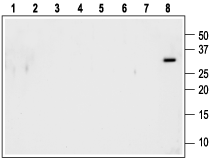Overview
- Peptide (C)DTELLRQQRRYNSPR, corresponding to amino acid residues 89-103 of human NT-3 (precursor) (Accession P20783). Pro-domain of the NT-3 protein.
- Recombinant mouse proNT-3.
 Western blot analysis using Anti-proNT-3 Antibody (#ANT-012) (1:600):1. Recombinant human Neurotrophin-3 (NT-3) protein (#N-260), (200 ng).
Western blot analysis using Anti-proNT-3 Antibody (#ANT-012) (1:600):1. Recombinant human Neurotrophin-3 (NT-3) protein (#N-260), (200 ng).
2. Recombinant human Neurotrophin-4 (NT-4) protein (#N-270), (200 ng).
3. Native mouse NGF 2.5S protein (>95%) (#N-100), (200 ng).
4. Recombinant human beta-NGF protein (#N-245), (200 ng).
5. Recombinant human BDNF protein (#B-250), (200 ng).
6. Recombinant mouse proNGF protein (#N-250), (200 ng).
7. Recombinant mouse proBDNF protein (#B-240), (200 ng).
8. Recombinant proNT-3, (10 ng). Western blot analysis of mouse recombinant proNT-3:1,5. 10 ng proNT-3.
Western blot analysis of mouse recombinant proNT-3:1,5. 10 ng proNT-3.
2,6. 50 ng proNT-3.
3,7. 100 ng proNT-3.
4,8. 200 ng proNT-3.
Lanes 1-4 Anti-proNT-3 Antibody (#ANT-012), (1:300).
Lanes 5-8 Anti-proNT-3 Antibody, preincubated with proNT-3 Blocking Peptide (#BLP-NT012).
- Mouse brain sections.
Brain derived neurotrophic factor (BDNF) is a member of the neurotrophin family of growth factors that includes nerve growth factor (NGF), neurotrophin-3 (NT-3) and neurotrophin-4/5 (NT-4/5).
All neurotrophins are synthesized as preproneurotrophin precursors that are subsequently processed within the intracellular transport pathway to yield proneurotrophins. These are further processed to generate the mature form. The mature form of BDNF is a non-covalent stable homodimer that can be secreted in both constitutive and regulated pathways.
Until recently, the functional role of the neurotrophin prodomain was thought to assist in the correct folding of the mature protein and the sorting of the neurotrophin into the constitutive or regulated secretory pathway. However, a growing body of evidence suggests that the uncleaved proneurotrophin precursors can be secreted from cells and that they may mediate different biological functions. Several studies implicate both proNGF and proBDNF in several physiological and pathological conditions.
It remains to be established whether proNT-3 has different biological functions than the mature NT-3 neurotrophin.
